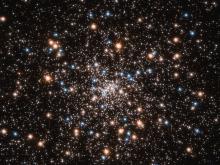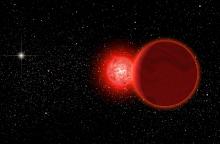Listen to today's episode of StarDate on the web the same day it airs in high-quality streaming audio without any extra ads or announcements. Choose a $8 one-month pass, or listen every day for a year for just $30.
You are here
Moon and Companions
The Moon and four other bright objects look like they’re having a block party the next few evenings. The Moon looks up at its companions tonight, stands in the middle of them tomorrow night, and waves goodbye on Wednesday.
The brightest member of the quartet is Venus, the “evening star.” It far outshines everything else in the night sky other than the Moon, so you can’t miss it. It’s also by far the closest member of the quartet now, at a distance of about 75 million miles. The planet will move even closer well into August, when it will cross between Earth and the Sun. It’ll reach a minimum distance of just 27 million miles — closer than any other planet ever gets.
Mars, on the other hand, is moving away from us. It was at its closest and brightest in December, when it shined brilliantly. As it retreats, though, it’s fading. This month, it looks like a modest orange star, well to the upper left of Venus.
The final members of the quartet are Pollux and Castor, the brightest stars of Gemini. The twins maintain the same brightness all the time. They’re so far away that a few million miles in either direction just doesn’t matter. Pollux is about 34 light-years off, while Castor is about 50 percent farther.
Venus will line up with the twins in late May and early June, while Mars will leave them behind as it moves eastward against the background of stars.
More about the Moon and twins tomorrow.
Script by Damond Benningfield






